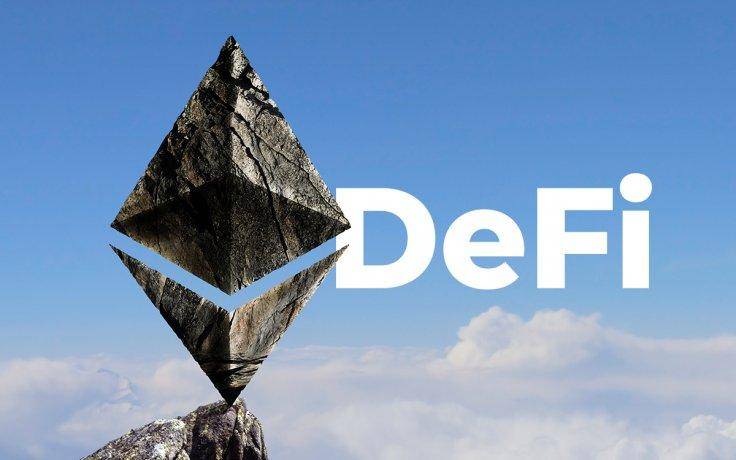DeFi market prospects in 2024: an important moment for technological innovation
In 2023, the decentralized finance landscape showed significant resilience and laid a solid foundation for expected growth in 2024. Despite facing the challenges of the bear market over the past year, DeFi projects have locked up approximately $43 billion in value, showing great potential. Among these projects, specific tokens and projects have outperformed others, marking key trends and areas of innovation in the DeFi space.
$MKR and $COMP were the main drivers of this trend, with $COMP skyrocketing by 83% in the week following the major project development. This situation correlates closely with the new project’s fundamentals, demonstrating the impact strategic leadership and innovation can have on a token’s value. In addition, the overall DeFi index consisting of the top 8 DeFi tokens by market capitalization is up 56% since mid-2023, outperforming other sectors such as GameFi and Stake. The rally marks the best performance for these coins since September 2022. They also outperform ETH compared to ETH.
These cases highlight the DeFi industry’s vitality and ability to cope with the bear market over the past year. In 2024, the DeFi industry will usher in transformative growth as Layer 2 technology develops, the regulatory environment evolves, and institutional interest increases.
In 2024, with the Cancun upgrade and the deployment of EIP-4844, the Layer 2 market is expected to experience significant growth. At the same time, lower transaction fees will stimulate more trading and financial activity.
The upcoming EIP-4844 is an important Ethereum improvement proposal that aims to introduce original danksharding to improve data availability and reduce aggregation costs. By increasing throughput and reducing costs, EIP-4844 is expected to enhance the scalability and efficiency of DeFi applications. This improvement is expected to lead to widespread adoption of more DeFi platforms as they become more user-friendly and can handle higher transaction volumes at lower costs. Additionally, increased scalability and efficiency provide opportunities for more complex financial products in DeFi, including complex derivatives, real-time settlement, and seamless integration of real-world assets through advanced tokenization processes. This will bring more choices and richer investment opportunities to users.

Adoption of Layer 2 solutions is key to attracting institutional investors and mainstream users, and marks an important shift in the trajectory of the DeFi market. Layer 2 development in 2024 is the cornerstone of DeFi’s growth, fueling DeFi’s growth, increasing its versatility, and enhancing integration with the broader financial ecosystem.
Over the past year, the entire crypto industry has faced increasing regulation, especially in the area of centralized exchanges (CEX). The SEC has filed lawsuits against exchanges such as Kraken, Coinbase, and Binance, which has had a certain negative impact on the crypto market. In addition, the news of CZ’s resignation as a leader in the encryption market has also cast a shadow on the regulatory situation of the encryption market in 2024.
The main trend in countries around the world is to gradually strengthen regulations to balance the relationship between cryptocurrency innovation, investor protection and financial stability. This is because there are growing concerns about the security, transparency and potential systemic risks of CEX platforms, and regulators are beginning to realize the importance of these issues. They are working to find a way to promote innovation while protecting investors from potential risks to maintain the stability of the financial system. This change in stance reflects regulators’ increased awareness of and emphasis on the cryptocurrency market.
For DeFi, the regulatory direction is more likely to involve clearer guidelines for the overall operation of DeFi projects, anti-money laundering compliance, and consumer protection measures. Optimistically, we may see collaboration between regulators and the DeFi ecosystem to establish a framework that promotes innovation while ensuring market integrity.
The issuance of Bitcoin spot ETF has always been a topic of widespread speculation and anticipation. If regulators continue to develop their understanding and approach to cryptocurrencies, we could see a Bitcoin ETF approved in 2024. This would mark an important milestone, potentially leading to greater institutional participation and mainstream acceptance of cryptocurrencies. However, this still depends on the regulatory environment being willing to accept such products, balancing potential risks with the advantages they offer in terms of market access and investor protection.
Although regulations are becoming increasingly strict, a better compliance legal system will also allow institutions to participate more in the cryptocurrency market and increase the adoption of DeFi. As regulatory frameworks become clearer and more inclusive, institutions that were previously hesitant due to legal uncertainty may become more confident in investing. Additionally, DeFi platforms continue to evolve to offer enhanced security and risk management tools that will make these platforms more attractive to institutions.

When traditional financial institutional investors with strong funds enter the DeFi field, they bring not only huge investments, but also higher requirements for security, compliance, transparency, etc. The influx of institutions will drive innovation and development in the DeFi field, resulting in more complex financial products and services that meet these high standards.
Growth in institutional adoption in 2024 could significantly increase the TVL of the DeFi market. At the same time, such growth will also add depth to the DeFi industry because such growth involves the professional traditional financial market knowledge that institutional players bring and their responsibilities to traditional investors. Their participation may lead to a more stable and mature DeFi market, potentially attracting more players from the traditional financial sector.
It is foreseeable that the cooperation between the regulatory government and traditional institutional participants will have a positive promotion effect on the DeFi market. All in all, 2024 will be another critical period for DeFi after DeFi Summer, marking the transformation of the entire market into a more integrated, stable and mature decentralized financial ecosystem.
To sum up, the DeFi market in 2023 has shown excellent flexibility and adaptability in a dynamic landscape. The year marked significant progress and a shift towards greater clarity and stability in the regulatory framework. The evolution of Layer 2 technology brings significant improvements in scalability and efficiency, laying the foundation for enhanced user experience and wider adoption. Looking ahead to 2024, potential adoption of DeFi by institutions is a key factor. This shift promises to inject significant capital, expertise, and credibility into the DeFi ecosystem, potentially facilitating its growth and maturity. As DeFi continues to evolve, it remains a vibrant and important part of the broader financial sector, blending innovation with emerging regulatory and institutional norms.
The above is the detailed content of DeFi market prospects in 2024: an important moment for technological innovation. For more information, please follow other related articles on the PHP Chinese website!

Hot AI Tools

Undresser.AI Undress
AI-powered app for creating realistic nude photos

AI Clothes Remover
Online AI tool for removing clothes from photos.

Undress AI Tool
Undress images for free

Clothoff.io
AI clothes remover

AI Hentai Generator
Generate AI Hentai for free.

Hot Article

Hot Tools

Notepad++7.3.1
Easy-to-use and free code editor

SublimeText3 Chinese version
Chinese version, very easy to use

Zend Studio 13.0.1
Powerful PHP integrated development environment

Dreamweaver CS6
Visual web development tools

SublimeText3 Mac version
God-level code editing software (SublimeText3)

Hot Topics
 1376
1376
 52
52
 Bitcoin historical price list 2015-2025 Bitcoin price trend charts in the past decade
Mar 12, 2025 pm 06:54 PM
Bitcoin historical price list 2015-2025 Bitcoin price trend charts in the past decade
Mar 12, 2025 pm 06:54 PM
This article reviews the ten-year price trend of Bitcoin from 2015 to 2025 in detail. Data shows that Bitcoin price fluctuates dramatically, experiencing huge changes from $200 to over $100,000. During this period, the price of Bitcoin was affected by a variety of factors, including halving of block rewards, market sentiment, regulatory policies, and global macroeconomic situation. The article analyzes the rise and fall of Bitcoin prices year by year, and focuses on interpreting the price changes in key years, providing a reference for investors to understand the history of Bitcoin prices and predict future trends. Keywords: Bitcoin price, Bitcoin trend, Bitcoin decade, digital currency, cryptocurrency
 Qubetics ($TICS): The Revolutionizing AI Crypto
Mar 23, 2025 am 10:08 AM
Qubetics ($TICS): The Revolutionizing AI Crypto
Mar 23, 2025 am 10:08 AM
Cryptocurrency has always been a realm where the cutting edge of technology meets bold ambition, and it's only getting more exciting in the future. As artificial intelligence continues to grow in influence, there are a handful of digital assets that
![Bitcoin [BTC] was on a downtrend after losing the $92,000-support level in the final week of February](https://img.php.cn/upload/article/001/246/273/174209101774967.jpg?x-oss-process=image/resize,m_fill,h_207,w_330) Bitcoin [BTC] was on a downtrend after losing the $92,000-support level in the final week of February
Mar 16, 2025 am 10:10 AM
Bitcoin [BTC] was on a downtrend after losing the $92,000-support level in the final week of February
Mar 16, 2025 am 10:10 AM
Technical indicators such as the OBV showed that selling pressure has been dominant, meaning more losses may be likely ahead.
 Pi Network (PI) Price Falls Despite Successful PiFest 2025 Event
Apr 03, 2025 am 10:08 AM
Pi Network (PI) Price Falls Despite Successful PiFest 2025 Event
Apr 03, 2025 am 10:08 AM
Pi Network recently held PiFest 2025, an event aimed at increasing the token's adoption. Over 125,000 sellers and 58,000 merchants participated
 Ethereum historical price trend chart 2015-2024 Ethereum k-line chart ten years trend trend
Mar 12, 2025 pm 06:57 PM
Ethereum historical price trend chart 2015-2024 Ethereum k-line chart ten years trend trend
Mar 12, 2025 pm 06:57 PM
This article reviews the price trend of Ethereum since its listing in 2015, from the initial $0.31, it experienced a surge in 2017 to nearly $1,400, as well as a market plunge in 2018 and 2022, and then hit a record high of $4,891.70 in 2021, as well as a rebound and stability in 2023. The article data covers the significant changes in Ethereum prices over each year and predicts price trends for 2024-2025, providing investors with a comprehensive historical reference and future outlook for Ethereum prices. Understand the history of Ethereum price fluctuations and seize investment opportunities!
 Top 10 digital currency app platforms rankings Virtual currency exchange latest rankings in 2025
Mar 13, 2025 pm 06:45 PM
Top 10 digital currency app platforms rankings Virtual currency exchange latest rankings in 2025
Mar 13, 2025 pm 06:45 PM
Top 10 digital currency app platforms: 1. OKX, 2. Binance, 3. Gate.io, 4. Kraken, 5. Coinbase, 6. Huobi, 7. KuCoin, 8. Crypto.com, 9. Bitfinex, 10. Gemini; these platforms are ranked according to factors such as transaction volume, security and user experience. When choosing, the platform's security, liquidity, transaction fees, currency selection, user interface and customer support should be considered.
 Where to download the genuine Ouyi? Official website download. Global
Mar 31, 2025 pm 02:09 PM
Where to download the genuine Ouyi? Official website download. Global
Mar 31, 2025 pm 02:09 PM
Ouyi usually refers to Ouyi OKX. The global way to download Ouyi OKX APP is as follows: 1. Android device: Download the APK file through the official website and install it. 2. iOS device: access the official website through the browser and directly download the APP.
 Cyber criminals were able to steal cryptocurrency worth 1.5 billion US dollars
Mar 16, 2025 am 11:12 AM
Cyber criminals were able to steal cryptocurrency worth 1.5 billion US dollars
Mar 16, 2025 am 11:12 AM
Since then, the provider has been investigating how this could have happened and how it will (hopefully) not happen again in the future.



